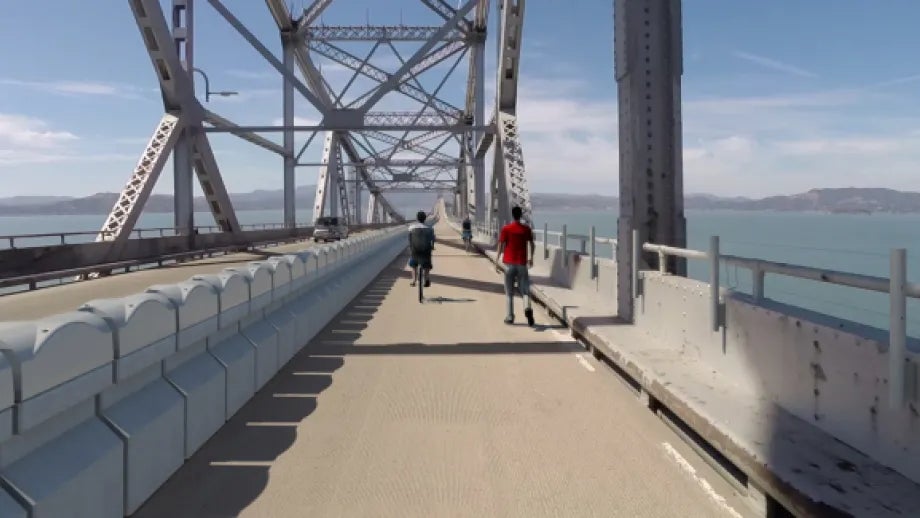Barrier Installation to Begin This Week For New Richmond-San Rafael Bridge Bike/Ped Path
Crews will begin work this week to install the moveable concrete barrier that will separate the two westbound traffic lanes on the upper deck of the Richmond-San Rafael Bridge from a new bicycle/pedestrian path expected to open later this fall. Installation work is scheduled to begin this evening, and will take place in the overnight hours of 9 p.m. to 5 a.m. This work will restrict westbound traffic across the bridge to the far left lane each weeknight through October. The four-mile-long bridge path will connect to another new bicycle/pedestrian path that runs along the north side of Interstate 580 in Richmond and is protected from freeway traffic by a permanent concrete barrier. Together, these bi-directional paths stretch for almost six miles from Castro Street in Richmond to East Francisco Blvd. in San Rafael, providing the first-ever route for bicyclists and pedestrians traveling between Marin County and the East Bay. These new paths are a key link in the planned 500-mile Bay Trail network.
Both the Richmond-San Rafael Bridge barrier and a barrier-transfer machine (also known as a “zipper truck”) were manufactured by, and will be installed by, Lindsay Transportation Solutions of Rio Vista, which also built and installed the roughly 2.5-mile-long moveable median barrier on the Golden Gate Bridge. Though conceptually similar to the 32-inch-tall Golden Gate Bridge barrier, each of the 3.28-foot-long segments of the Richmond-San Rafael Bridge barrier features a plastic attachment that raises its height to 42 inches to meet published standards for bicycle safety railings. The individual barrier sections weigh 1,575 pounds and feature rubber feet to prevent water from pooling at the barrier’s base and to prevent damage to the concrete bridge deck. Once the barrier is fully installed, trained crews using the “zipper truck” will be able to quickly reposition it as necessary to allow crews working for Caltrans and the Bay Area Toll Authority (BATA) to complete bridge maintenance tasks during short closures of the bike/ped path.
The $20 million Richmond-San Rafael bicycle/pedestrian path and the $36 million third eastbound traffic lane that opened on the lower deck of the bridge in April 2018 both were developed as four-year pilot projects through a partnership between BATA, Caltrans, the Contra Costa Transportation Authority (CCTA) and the Transportation Authority of Marin (TAM).
Performance of the new bike/ped path will be monitored and assessed continually as hard data becomes available on the use of the path by bicyclists and pedestrians, and operational adjustments will be made as needed. This evaluation will include a before-and-after study conducted by Caltrans and the University of California’s Partners for Advanced Transportation Technology (PATH) program. BATA and Caltrans are now conducting a study of the bridge’s load rating to evaluate the span’s structural capacity for both current and future conditions. This study is slated for completion in the spring of 2020 and will include analysis of three westbound traffic lanes with the moveable barrier on the upper deck. TAM also has begun working on a corridor traffic analysis to identify improvements that may be needed on the Marin County side of the bridge to accommodate three lanes of westbound traffic across the span.
BATA, which administers all toll revenues from the Bay Area’s seven state-owned toll bridges, provided the funding for both the Richmond-to-San Rafael bike/ped path and the third peak-period traffic lane from San Rafael to Richmond. Caltrans owns and operates the state highway system, including the Richmond-San Rafael Bridge. CCTA was formed by Contra Costa County voters in 1988 to manage the county’s transportation sales tax program and to oversee county transportation planning efforts. TAM, which administers the expenditure plans for Marin County’s transportation sales tax and its $10 Measure B vehicle registration fee, serves as the county’s congestion management agency and coordinates funding for transportation projects and programs throughout Marin County.

